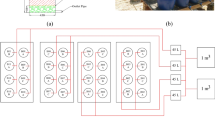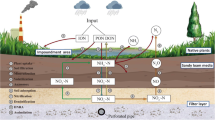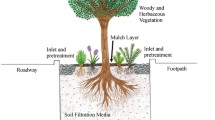Abstract
Bioretention systems have been implemented as stormwater best management practices (BMPs) worldwide to treat non-point sources pollution. Due to insufficient research, the design guidelines for bioretention systems in tropical countries are modeled after those of temperate countries. However, climatic factors and stormwater runoff characteristics are the two key factors affecting the capacity of bioretention system. This paper reviews and compares the stormwater runoff characteristics, bioretention components, pollutant removal requirements, and applications of bioretention systems in temperate and tropical countries. Suggestions are given for bioretention components in the tropics, including elimination of mulch layer and submerged zone. More research is required to identify suitable additives for filter media, study tropical shrubs application while avoiding using grass and sedges, explore function of soil faunas, and adopt final discharged pollutants concentration (mg/L) on top of percentage removal (%) in bioretention design guidelines.

Similar content being viewed by others
Change history
22 September 2023
A Correction to this paper has been published: https://doi.org/10.1007/s11356-023-29713-0
References
Adugna AT, Andrianisa HA, Konate Y, Ndiaye A, Maiga AH (2015) Performance comparison of sand and fine sawdust vermifilters in treating concentrated grey water for urban poor. Environ Technol 36:2763–2769
Ayers EM (2009) Pedogenesis in rain gardens: the role of earthworms and other organisms in long-term soil development, University of Maryland, College Park
Barrett ME, Limouzin M, Lawler DF (2013) Effects of media and plant selection on biofiltration performance. J Environ Eng 139:462–470
Blecken G, Zinger Y, Muthanna TM, Deletic A, Fletcher TD, Viklander M (2007) The influence of temperature on nutrient treatment efficiency in stormwater biofilter systems. Water Sci Technol 56:83–91
Bratieres K, Fletcher T, Deletic A, Zinger Y (2008) Nutrient and sediment removal by stormwater biofilters: a large-scale design optimisation study. Water Res 42:3930–3940
Brown R, Hunt W (2011) Underdrain configuration to enhance bioretention exfiltration to reduce pollutant loads. J Environ Eng 137:1082–1091
Brown RA, Hunt WF III (2010) Impacts of media depth on effluent water quality and hydrologic performance of undersized bioretention cells. J Irrig Drain Eng 137:132–143
Carpenter DD, Hallam L (2009) Influence of planting soil mix characteristics on bioretention cell design and performance. J Hydrol Eng 15:404–416
Chapman C, Horner RR (2010) Performance assessment of a street-drainage bioretention system. Water Environ Res 82:109–119
Chapuis-Lardy L, Le Bayon RC, Brossard M, López-Hernández D., Blanchart E (2011) Role of soil macrofauna in phosphorus cycling. Phosphorus in Action. Springer
Chen X, Peltier E, Sturm BS, Young CB (2013) Nitrogen removal and nitrifying and denitrifying bacteria quantification in a stormwater bioretention system. Water Res 47:1691–1700
Chen XC, Huang L, Ong BL (2014) The phytoremediation potential of a Singapore Forest tree for bioretention systems. J Mater Sci Eng A 4:220–227
Cho KW, Song KG, Cho JW, Kim TG, Ahn KH (2009) Removal of nitrogen by a layered soil infiltration system during intermittent storm events. Chemosphere. 76:690–696
Chow M, Yusop Z (2014) Characterization and source identification of stormwater runoff in tropical urban catchments. Water Sci Technol 69:244–252
Colloff MJ, Pullen KR, Cunningham SA (2010) Restoration of an ecosystem function to revegetation communities: the role of invertebrate macropores in enhancing soil water infiltration. Restor Ecol 18:65–72
Davis AP (2007) Field performance of bioretention: water quality. Environ Eng Sci 24:1048–1064
Davis AP, Shokouhia M, Sharma H, Minami C (2006) Water quality improvement through bioretention media: nitrogen and phosphorus removal. Water Environ Res 78:284–293
Davis AP, Hunt WF, Traver RG, Clar M (2009) Bioretention technology: overview of current practice and future needs. J Environ Eng 135:109–117
DEP (2006) Pennsylvania stormwater best management practices manual. Pennsylvania Department Of Environmental Protection, US
DID (2012) Urban stormwater management for Malaysia, 2nd edn. Malaysia Department of Drainage and Irrigation (DID) Malaysia, Kuala Lumpur
Dietz ME (2007) Low impact development practices: a review of current research and recommendations for future directions. Water Air Soil Pollut 186:351–363
Dietz ME, Clausen JC (2006) Saturation to improve pollutant retention in a rain garden. Environmental Science and Technology, 40:1335–1340
DOE (2012) Malaysia environmental quality report. Strategic Communication Division, Department of Environment Malaysia (DOE), Putrajaya
Duncan HP (1999) Urban stormwater quality: a statistical review, Ed. Wong, THF, Engineers Australia
Ellerton J, Hatt B, Fletcher T (2012) Mixed plantings of Carex appressa and Lomandra longifolia improve pollutant removal over a monoculture of ‘L. longifolia’ in stormwater biofilters. WSUD 2012: water sensitive urban design; Building the water sensiitve community; 7th international conference on water sensitive urban design. 2012. Engineers Australia, p 164
Geronimo FKF, Maniquiz-Redillas MC, Kim LH (2013) Treatment of parking lot runoff by a tree box filter. Desalin Water Treat 51:4044–4049
Geronimo FKF, Maniquiz-Redillas MC, Kim LH (2014) Fate and removal of nutrients in bioretention systems. Desalin Water Treat 53:3072–3079
Gilchrist S, Borst M, Stander EK (2013) Factorial study of rain garden design for nitrogen removal. J Irrig Drain Eng 140:04013016
Glaister BJ, Fletcher TD, Cook PL, Hatt BE (2014) Co-optimisation of phosphorus and nitrogen removal in stormwater biofilters: the role of filter media, vegetation and saturated zone. Water Sci Technol 69:1961–1969
Goh HW, Zakaria NA, Lau TL, Foo KY, Chang CK, Leow CS (2017) Mesocosm study of enhanced bioretention media in treating nutrient rich stormwater for mixed development area. Urban Water J 14:134–142
González G, Seastedt TR (2001) Soil fauna and plant litter decomposition in tropical and subalpine forests. Ecology 82:955–964
Guo H, Lim F, Zhang Y, Lee L, Hu J, Ong S, Yau W, Ong G (2014) Soil column studies on the performance evaluation of engineered soil mixes for bioretention systems. Desalin Water Treat 52:3661–3667
Hathaway J, Hunt WF, Wright J, Jadlocki S (2009) Field evaluation of indicator bacteria removal by stormwater BMPs in North Carolina. World environmental and water resources congress 2009: Great Rivers 2009, pp 1–10
Hatt BE, Fletcher TD, Deletic A (2008) Hydraulic and pollutant removal performance of fine media stormwater filtration systems. Environ Sci Technol 42:2535–2541
Hatt BE, Fletcher TD, Deletic A (2009) Hydrologic and pollutant removal performance of stormwater biofiltration systems at the field scale. J Hydrol 365:310–321
Henderson CFK (2009) The chemical and biological mechanisms of nutrient removal from stormwater in bioretention systems. Griffith University
Hermawan AA, Chang JW, Pasbakhsh P, Hart F, Talei A (2018) Halloysite nanotubes as a fine grained material for heavy metal ions removal in tropical biofiltration systems. Appl Clay Sci 160:106–115
Ho C, Tan Y (2013) Pollutant loads of urban runoff from a mixed residential-commercial catchment. World Acad Sci Eng Technol 7:492–495
Horn MA, Mertel R, Gehre M, Kästner M, Drake HL (2006) In vivo emission of dinitrogen by earthworms via denitrifying bacteria in the gut. Appl Environ Microbiol 72:1013–1018
Hsieh C, Davis A (2005) Evaluation and optimization of bioretention media for treatment of urban storm water runoff. J Environ Eng 131:1521–1531
Hsieh C, Davis AP, Needelman BA (2007a) Bioretention column studies of phosphorus removal from urban stormwater runoff. Water Environ Res 79:177–184
Hsieh C, Davis AP, Needelman BA (2007b) Nitrogen removal from urban stormwater runoff through layered bioretention columns. Water Environ Res 79:2404–2411
Hudak PF, Banks KE (2006) Compositions of first flush and composite storm water runoff in small urban and rural watersheds, north-central Texas. Urban Water J 3:43–49
Hunt WF, Lord WG (2006) Bioretention performance, design, construction, and maintenance. North Carolina Cooperative Extension, Raleigh
Hunt W, Jarrett A, Smith J, Sharkey L (2006) Evaluating bioretention hydrology and nutrient removal at three field sites in North Carolina. J Irrig Drain Eng 132:600–608
Hunt W, Smith J, Jadlocki S, Hathaway J, Eubanks P (2008) Pollutant removal and peak flow mitigation by a bioretention cell in urban Charlotte. NC J Environ Eng 134:403–408
Hunt WF, Lord B, Loh B, Sia A (2015) Plant selection for bioretention systems and stormwater treatment practices. Springer
Iqbal H, Garcia-Perez M, Flury M (2015) Effect of biochar on leaching of organic carbon, nitrogen, and phosphorus from compost in bioretention systems. Sci Total Environ 521-522:37–45
Jang A, Seo Y, Bishop PL (2005) The removal of heavy metals in urban runoff by sorption on mulch. Environ Pollut 133:117–127
Jia H, Wang Z, Zhen X, Clar M, Yu SL (2017) China’s sponge city construction: a discussion on technical approaches. Front Environ Sci Eng 11:18
Jouquet P, Huchet G, Bottinelli N, Thu TD, Duc TT (2012) Does the influence of earthworms on water infiltration, nitrogen leaching and soil respiration depend on the initial soil bulk density? A mesocosm experiment with the endogeic species Metaphire posthuma. Biol Fertil Soils 48:561–567
Kappes H, Topp W, Zach P, Kulfan J (2006) Coarse woody debris, soil properties and snails (Mollusca: Gastropoda) in European primeval forests of different environmental conditions. Eur J Soil Biol 42:139–146
Kazemi F, Beecham S, Gibbs J (2009) Streetscale bioretention basins in Melbourne and their effect on local biodiversity. Ecol Eng 35:1454–1465
Kim H, Seagren EA, Davis AP (2003) Engineered bioretention for removal of nitrate from stormwater runoff. Water Environ Res 75:355–367
Le Coustumer S, Fletcher TD, Deletic A, Barraud S, Poelsma P (2012) The influence of design parameters on clogging of stormwater biofilters: a large-scale column study. Water Res 46:6743–6752
LeFevre GH, Paus KH, Natarajan P, Gulliver JS, Novak PJ, Hozalski RM (2014) Review of dissolved pollutants in urban storm water and their removal and fate in bioretention cells. J Environ Eng 141:04014050
Li L, Davis AP (2014) Urban stormwater runoff nitrogen composition and fate in bioretention systems. Environ Sci Technol 48:3403–3410
Liu J, Davis AP (2013) Phosphorus speciation and treatment using enhanced phosphorus removal bioretention. Environ Sci Technol 48:607–614
Liu J, Sample DJ, Bell C, Guan Y (2014a) Review and research needs of bioretention used for the treatment of urban stormwater. Water. 6:1069–1099
Liu J, Sample DJ, Owen JS, Li J, Evanylo G (2014b) Assessment of selected bioretention blends for nutrient retention using mesocosm experiments. J Environ Qual 43:1754–1763
Lucas WC, Greenway M (2008) Nutrient retention in vegetated and nonvegetated bioretention mesocosms. J Irrig Drain Eng 134:613–623
Lucas WC, Greenway M (2011) Hydraulic response and nitrogen retention in bioretention mesocosms with regulated outlets: part II—nitrogen retention. Water Environ Res 83:703–713
Lucke T, Drapper D, Hornbuckle A (2018) Urban stormwater characterisation and nitrogen composition from lot-scale catchments—new management implications. Sci Total Environ 619:65–71
Luell S, Hunt W, Winston R (2011) Evaluation of undersized bioretention stormwater control measures for treatment of highway bridge deck runoff. Water Sci Technol 64:974–979
Luo H, Li M, Xu R, Fu X, Huang G, Huang X (2012) Pollution characteristics of urban surface runoff in a street community. Sustain Environ Res 22:61–68
Mangangka IR, Liu A, Egodawatta P, Goonetilleke A (2015) Performance characterisation of a stormwater treatment bioretention basin. J Environ Manag 150:173–178
MDE (2000) Maryland Stormwater Design Manual. Maryland Department of The Evironment, Maryland
Mehring AS, Levin LA (2015) REVIEW: potential roles of soil fauna in improving the efficiency of rain gardens used as natural stormwater treatment systems. J Appl Ecol 52:1445–1454
Meysman FJR, Middelburg JJ, Heip CHR (2006) Bioturbation: a fresh look at Darwin’s last idea. Trends Ecol Evol 21:688–695
MHURC (2014) Technical guidelines on Sponge City construction—low impact development stormwater management system (trial). China Ministry of Housing and Urban-Rural Construction, China
Milandri S, Winter K, Chimphango S, Armitage N, Mbui D, Jackson G, Liebau V (2012) The performance of plant species in removing nutrients from stormwater in biofiltration systems in Cape Town. Water SA 38:655–662
Muerdter CP, Wong CK, LeFevre GH (2018) Emerging investigator series: the role of vegetation in bioretention for stormwater treatment in the built environment: pollutant removal, hydrologic function, and ancillary benefits. Environ Sci Water Res Technol 4:592–612
NJDEP (2009) New Jersey Stormwater Best Management Practices Manual. Chapter four: stormwater pollutant removal criteria. Department of Environmental Protection, Division of Watershed Management, State of New Jersey
NJDEP (2016) New Jersey Stormwater Best Management Practices Manual. Chapter 9.1: bioretention systems. New Jersey Department of Environmental Protection, New Jersey
O’Neill SW, Davis AP (2011) Water treatment residual as a bioretention amendment for phosphorus. II: Long-term column studies. J Environ Eng 138:328–336
Palmer ET, Poor CJ, Hinman C, Stark JD (2013) Nitrate and phosphate removal through enhanced bioretention media: mesocosm study. Water Environ Res 85:823–832
Paus K, Morgan J, Gullive J, Hozalski R (2014) Effects of bioretention media compost volume fraction on toxic metals removal, hydraulic conductivity, and phosphorous release. J Environ Eng 140:04014033
Payne EG, Pham T, Cook PL, Fletcher TD, Hatt BE, Deletic A (2014) Biofilter design for effective nitrogen removal from stormwater–influence of plant species, inflow hydrology and use of a saturated zone. Water Sci Technol 69:1312–1319
Payne EGI, Hatt BE, Deletic A, Dobbie MF, McCarthy DT, Chandrasena GI (2015) Adoption guidelines for stormwater biofiltration systems. Cooperative Research Centre for Water Sensitive Cities, Melbourne
Payne EGI, Pham T, Deletic A, Hatt BE, Cook PLM, Fletcher TD (2018) Which species? A decision-support tool to guide plant selection in stormwater biofilters. Adv Water Resour 113:86–99
Peterson IJI, Igielski S., Davis AP (2015) Enhanced denitrification in bioretention using woodchips as an organic carbon source Journal of Sustainable Water in the Built Environment 04015004
PGC (2007) The bioretention manual. Environmental Service Div., Department of Environmental Resources, Prince George’s County, Maryland
Pop PI, Dîrja M, Dumitraș A (2013) Outdoor experimental mesocosm construction for the evaluation of bioretention in Cluj-Napoca condition. Bulletin of University of Agricultural Sciences and Veterinary Medicine Cluj-Napoca. Horticulture, p 69
PUB (2011) Engineering procedures for ABC waters design features. Public Utilities Board (PUB), Singapore
PUB (2014) Active, beautiful, clean waters design guidelines, 3rd edn. Public Utilities Board, Singapore
Read J, Wevill T, Fletcher T, Deletic A (2008) Variation among plant species in pollutant removal from stormwater in biofiltration systems. Water Research, 42:893–902
Roy-Poirier A, Champagne P, Filion Y (2010) Review of bioretention system research and design: past, present, and future. J Environ Eng 136:878–889
Shipitalo M, Le Bayon R (2004) Quantifying the effects of earthworms on soil aggregation and porosity. In: Edwards CA (ed) Earthworm ecology, 2nd edn. CRC Press, Boca Raton, pp 183–200
Stander EK, Borst M (2009) Hydraulic test of a bioretention media carbon amendment. J Hydrol Eng 15:531–536
Suárez ER, Pelletier DM, Fahey TJ, Groffman PM, Bohlen PJ, Fisk MC (2004) Effects of exotic earthworms on soil phosphorus cycling in two broadleaf temperate forests. Ecosystems 7:28–44
Suhaila J, Jemain AA (2012) Spatial analysis of daily rainfall intensity and concentration index in peninsular Malaysia. Theor Appl Climatol 108:235–245
Sun X, Davis AP (2007) Heavy metal fates in laboratory bioretention systems. Chemosphere. 66:1601–1609
Taylor M, Clarke W, Greenfield P (2003) The treatment of domestic wastewater using small-scale vermicompost filter beds. Ecol Eng 21:197–203
Trowsdale SA, Simcock R (2011) Urban stormwater treatment using bioretention. J Hydrol 397:167–174
Turk RP, Kraus HT, Hunt WF, Carmen NB, Bilderback TE (2017) Nutrient sequestration by vegetation in bioretention cells receiving high nutrient loads. J Environ Eng 143:06016009
Wang J, Chua LH, Shanahan P (2017) Evaluation of pollutant removal efficiency of a bioretention basin and implications for stormwater management in tropical cities. Environ Sci Water Res Technol 3:78–91
Water By Design (2014) Bioretention technical design guidelines (version 1.1). Health Waterways Ltd, Brisbane
Wurst S, Langel R, Reineking A, Bonkowski M, Scheu S (2003) Effects of earthworms and organic litter distribution on plant performance and aphid reproduction. Oecologia 137:90–96
Zhang L, Seagren EA, Davis AP, Karns JS (2011a) Long-term sustainability of Escherichia coli removal in conventional bioretention media. J Environ Eng 137:669–677
Zhang Z, Rengel Z, Liaghati T, Antoniette T, Meney K (2011b) Influence of plant species and submerged zone with carbon addition on nutrient removal in stormwater biofilter. Ecol Eng 37:1833–1841
Zinger Y, Blecken GT, Fletcher TD, Viklander M, Deletić A (2013) Optimising nitrogen removal in existing stormwater biofilters: benefits and tradeoffs of a retrofitted saturated zone. Ecol Eng 51:75–82
Funding
This work was supported by the Division of Research & Innovation, Universiti Sains Malaysia under the grant title of “Influence of Enhanced Bioretention Media and Tropical Shrub on Nutrient Removal for Urban Runoff in Mixed Development Area: An On-Site Study” with grant number as: 203/PKT/6720004.
Author information
Authors and Affiliations
Corresponding author
Additional information
Responsible editor: Philippe Garrigues
Publisher’s note
Springer Nature remains neutral with regard to jurisdictional claims in published maps and institutional affiliations.
Rights and permissions
Springer Nature or its licensor (e.g. a society or other partner) holds exclusive rights to this article under a publishing agreement with the author(s) or other rightsholder(s); author self-archiving of the accepted manuscript version of this article is solely governed by the terms of such publishing agreement and applicable law.
About this article
Cite this article
Goh, H.W., Lem, K.S., Azizan, N.A. et al. A review of bioretention components and nutrient removal under different climates—future directions for tropics. Environ Sci Pollut Res 26, 14904–14919 (2019). https://doi.org/10.1007/s11356-019-05041-0
Received:
Accepted:
Published:
Issue Date:
DOI: https://doi.org/10.1007/s11356-019-05041-0




